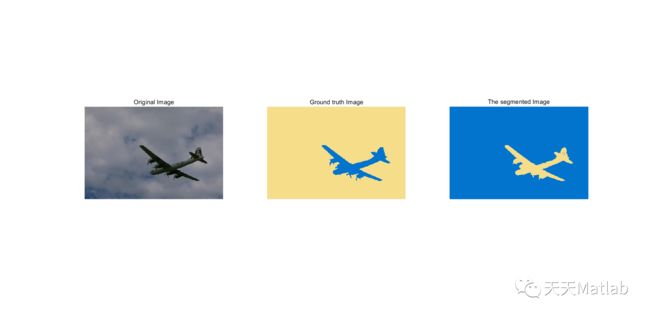【图像分割】基于模糊C均值聚类算法CGFFCM实现彩色图像分割附matlab代码
1 简介
The fuzzy c-means (FCM) algorithm is a popular method for data clustering and image segmentation. However, the main problem of this algorithm is that it is very sensitive to the initialization of primary clusters, so it may not perform well in segmenting complex images. Another problem with the FCM is the equal importance of the image features used during the segmentation process, which causes unstable performance on different images. In this paper, we propose an FCM-based color image segmentation approach, termed CGFFCM, applying an automatic cluster weighting scheme to reduce the sensitivity to the initialization, and a group-local feature weighting strategy to better image segmentation. Also, we combine the proposed clustering algorithm with the Imperialist Competitive Algorithm (ICA) to optimize the feature weighting process. In addition, we apply an efficient combination of image features to increase the segmentation quality. The performance of CGFFCM is evaluated and compared with state-of-the-art methods (such as SMKIFC (semi-supervised surrogate-assisted multi-objective kernel intuitionistic fuzzy clustering), and A-PSO-IT2IFCM (alternate particle swarm optimization based adaptive interval type-2 intuitionistic FCM clustering algorithm)) using the Berkeley benchmark dataset. The results obtained by CGFFCM are 95%, 79%, and 91%, in terms of average Accuracy, NMI, and F-score metrics, respectively, which all are better than the competitors.
2 部分代码
clcclear allclose all%% Load dataset.%Load imageImg = imread('3096.jpg');%Load the class.B=load('class3096.mat');B=B.class3096;class=double(reshape(B,[size(B,1)*size(B,2) 1]));%% Show the image and its Ground truth.% axis off% img = frame2im(getframe(gca));% imwrite(Img,'113044.png');Color_Map=[0.960012728938293,0.867750283531604,0.539798806341941;0.00620528530061783,0.456645636880323,0.807705802687295;0.16111134052427435,0.0634483119173452,0.321794465524281;0.394969976441930,0.662682208014249,0.628325568854317;0.0945269059837998,0.794795142853933,0.473068960772494];Ground_truth = label2rgb(B,Color_Map);% axis off% img = frame2im(getframe(gca));% imwrite(Ground_truth,'class134052.png');%% Feathre Extract stepfprintf('The feature extraction phase has started ...\n')X = FeatureExtractor(Img);[N,d]=size(X);%% Algorithm parameters.% for each image, ICA algorithm run and Group Weight values are reported.% Also, best values for q and landa are listed.% for get best, rsult we use parameters as fallows:%==========================================================================% Image Weight(G1=V) Weight(G2=V) Weight(G3=V) landa(oo) q(beta_z)% 67079 0.0 1 0.0 0.0001 2% 101027 0.2 0.6 0.2 0.0001 -2% 118035 0.4 0.6 0.0 0.0010 -2% 167062 0.4 0.1 0.5 1.0000 2% 108073 0.7 0.1 0.2 0.0010 -2% 113016 0.7 0.2 0.1 0.0100 -8% 113044 0.3 0.6 0.1 0.1000 4% 134052 0.5 0.4 0.1 0.1000 6% 135069 0.1 0.7 0.2 0.0100 -6% 238011 0.1 0.1 0.8 0.0001 2% 299091 0.1 0.8 0.1 0.1000 6% 3096 0.1 0.7 0.2 0.0001 -10% 80099 0.3 0.6 0.1 0.0100 -2%==========================================================================k=size(unique(class),1); % number of clusters.beta_z = -10; % The power value of the feature weight(in paper).p_init = 0; % initial p.p_max = 0.5; % maximum p.p_step = 0.01; % p step.t_max = 100; % maximum number of iterations.beta_memory = 0.3; % amount of memory for the weights updates.Restarts = 1; % number of CGFFCM restarts.fuzzy_degree = 2; % fuzzy membership degreev(1,1:3) = 0.1; % Weight of group 1v(1,4:6) = 0.7; % Weight of group 2v(1,7:8) = 0.2; % Weight of group 3G = [1 1 1 2 2 2 3 3]; % Feature Groups (three group 1, 2 and 3)oo=0.0001; % interval (0,1]landa=oo./var(X); % the inverse variance of the m-th featureTF = find(isinf(landa)==1);if ~isempty(TF)for i=1:size(TF,2)landa(1,TF(i))=nan;endaa=max(landa);for i=1:size(TF,2)landa(1,TF(i))=aa+1;endend%% Cluster the instances using the CGFFCM procedure.best_clustering=zeros(1,N);for repeat=1:Restartsfprintf('========================================================\n')fprintf('CGFFCM: Restart %d\n',repeat);%Randomly initialize the cluster centers.rand('state',repeat)tmp=randperm(N);M=X(tmp(1:k),:);%Execute CGFFCM.%Get the cluster assignments, the cluster centers and the cluster variances.[Cluster_elem,M,EW_history,W,z]=CGFFCM(X,M,k,p_init,p_max,p_step,t_max,beta_memory,N,fuzzy_degree,d,beta_z,landa,v,G);[~,Cluster]=max(Cluster_elem,[],1);%MeauresEVAL = Evaluate(class,Cluster');accurcy_ave(repeat)=EVAL(1);fm_ave(repeat)=EVAL(2);nmi_ave(repeat)=EVAL(3);if best_clustering ~= 0if accurcy_ave(repeat) > accurcy_ave(repeat-1)best_clustering = Cluster;endelsebest_clustering = Cluster;endfprintf('End of Restart %d\n',repeat);fprintf('========================================================\n\n')end%% Results% Show the best segmented imagecmap = reshape(best_clustering', [size(double(Img),1) size(double(Img),2)]);clusteredImage = label2rgb(cmap,Color_Map);figure(1),subplot(131),imshow(Img),title('Original Image');,subplot(132),imshow(Ground_truth),title('Ground truth Image');,subplot(133),imshow(clusteredImage),title('The segmented Image');% axis off% img = frame2im(getframe(gca));% imwrite(clusteredImage,'cluster134052.png');fprintf('Average accurcy score over %d restarts: %f.\n',Restarts,mean(accurcy_ave));fprintf('Average F-Measure score over %d restarts: %f.\n',Restarts,mean(fm_ave));fprintf('Average NMI score over %d restarts: %f.\n',Restarts,mean(nmi_ave));
3 仿真结果
4 参考文献
[1]卜娟, 王向阳, 孙艺峰. 基于模糊C均值聚类的多分量彩色图像分割算法[J]. 中国图象图形学报, 2008, 13(10):1837-1840.
[2] Agoa B , Mha B , Baa B , et al. CGFFCM: Cluster-weight and Group-local Feature-weight learning in Fuzzy C-Means clustering algorithm for color image segmentation - ScienceDirect[J]. 2021.
博主简介:擅长智能优化算法、神经网络预测、信号处理、元胞自动机、图像处理、路径规划、无人机等多种领域的Matlab仿真,相关matlab代码问题可私信交流。
部分理论引用网络文献,若有侵权联系博主删除。
